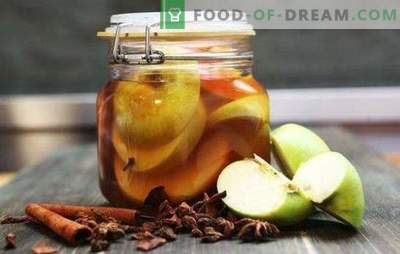
Apple cider vinegar is obtained by microbiological method from fresh apples (pulp or juice). Vinegar, obtained as a result of fermentation, has a richer taste and natural properties in contrast to alcohol. It tastes much softer and more aromatic, is well absorbed, helps to improve the intestinal microflora. Prepare apple cider vinegar at home is best in late autumn, when winter varieties of apples ripen.
Benefits of Homemade Apple Cider Vinegar
In the process of making vinegar, the products are not heated or sterilized, so all the beneficial substances from apples are preserved. In house vinegar there are no flavors, dyes and other additives, the strength does not exceed 4-6%. It does not have such a presentable appearance as a purchased one, since it does not undergo pasteurization and is not refined (cleared of impurities). But it is in this muddy vinegar with natural sediment contains all the nutrients and enzymes.
In winter, apples gradually lose their beneficial properties, and all the vitamins are preserved in vinegar.
Apple vinegar contains more than 60 organic compounds, many useful substances:
• 16 amino acids - essential for maintaining protein structure;
• natural sugars;
• vitamins (groups A, B1, B2, B6, C, E), provitamin beta carotene;
• mineral substances (iron, potassium, calcium, silicon, magnesium, sodium, phosphorus, sulfur);
• organic acids (lactic, citric, oxalic, acetic, malic);
• phenolic substances - are involved in redox reactions, form the taste properties of products;
• acetic acid bacteria (UCB) Acetobacteraceae - necessary for normal fermentation in the digestive tract.
Enzymes, complex protein molecules in apple cider vinegar accelerate biochemical reactions and improve metabolic processes.
Homemade vinegar is used as a seasoning in cooking, as a preservative for the preparation of seasonal preparations of vegetables and fruits. It is used in compliance with the diet and in the diet of healthy eating. There are many recipes for beauty whitening and smoothing the face, to improve the structure of the hair and give them a silky shine.
Methods of cooking apple cider vinegar
This is a multi-step process: first, the sugar in the fruit mass produces ethyl alcohol (apple wine), and then the alcohol is oxidized by special bacteria to acetic acid.
Apple cider vinegar preparation consists of the following steps:
• fermentation and fermentation - the biochemical process in the prepared raw materials under the influence of enzymes, resulting in organic substances decompose, this processing of sugar by yeast, which are microscopic fungi and feed on sugar (added or as part of natural raw materials), without access of air, as a result young wine with a strength of 6-8%;
• souring - the conversion of wine alcohol to vinegar under the influence of bacteria Acetobacteraceae, which are activated when oxygen enters and oxidizes ethanol to acetic acid, acetic fungus is formed on the surface of the raw material, which is a dense semi-transparent mass, after some time it settles to the bottom, which means the process stops ;
• filtering the finished vinegar, packaging in containers and storage, preferably in the refrigerator or in a dark cool place to + 16 + 18 ° C.
The main methods of preparation depend on the components: use apples or apple juice, sugar, yeast.
The first recipe for apple cider vinegar at home
Apples to clean and prepare the juice on a juicer or in any other way, pour it into a 3-liter jar. Wear a rubber ball on the neck of the jar and leave it in a warm place for 3-4 weeks. The ball is inflated from the carbon dioxide emitted during the fermentation process, you can make a needle or toothpick puncture (although some are categorically against it, everything is determined by experiment), replace the burst ball with a new one. As soon as the ball starts to deflate, then fermentation is complete and you can proceed to the next stage.
After a month, pour the contents into a wide saucepan, cover with a towel or napkin and leave for another 1.5 months. The larger the surface area, the faster the process of interaction of acetic acid bacteria occurs and the oxidation of products is completed. During the fermentation process, the mass will seethe and foam, so leave 5-6 cm to the brim. You do not need to remove foam and vinegar from the surface, they are necessary for normal oxidation. When the fungus sinks to the bottom, the sharp and unpleasant smell disappears, then the vinegar is ready for use.
The second recipe for apple cider vinegar at home
Fruits cut into slices into 5-6 parts and leave for 2-3 hours until dark under the influence of atmospheric oxygen, which oxidizes iron in the composition of apples. Then make juice from slices in any convenient way, which is also left for 2-3 hours for oxidation. Periodically it is necessary to stir it in order for the juice to become saturated in caramel color. The prepared liquid is poured into a jar or bottle, and the neck is closed with a rubber ball.
When the ball starts to deflate, pour the contents into a wider container, without adding several centimeters to the edges. Cover the pot with a towel and leave for about 1.5 months. The process is completed, when the liquid becomes transparent, you can strain it and pour it into bottles.
The third recipe for apple cider vinegar at home
3.2 kg of sweet apples
1 liter of water
200 g sugar
Grate apples or chop with a blender, put in a ceramic or enameled pan (in no case aluminum), pour cool boiled water and add 100 g of sugar, mix well to dissolve the sugar. Cover the pot with a towel, not a lid, for constant air access and leave for three weeks, stirring daily with a wooden spoon.
After three weeks, strain the mass, add 100 g of sugar and pour into a clean container, which should also be covered with a towel and left for 3 weeks again. Gradually, the mixture will brighten, then it will become almost transparent, which means the fermentation process is over and the vinegar is ready for use. The resulting liquid is filtered through cheesecloth or a small colander and bottled with tight lids.
The fourth recipe for apple cider vinegar at home
4.4 kg apples
200 g of water
1 tbsp. l Sahara
0.5 tbsp. l dry yeast
Apples chop and squeeze the juice, pour it into a jar or bottle. Dissolve yeast, sugar and warm boiled water in a cup, pour it into a container with apple juice in 30-40 minutes. Put a rubber ball on the jar and leave it for 4 weeks. Then pour the apple wine in a wide saucepan, cover with a towel and leave for about 1-1.5 months, then strain and pour for storage.
The fifth recipe for apple cider vinegar at home
5.4 kg of apple juice (after juicing)
1 liter of water
500 grams of sugar
100 g black bread
Apple squeezes pour warm boiled water, add sugar and pieces of black bread, leave in a saucepan under a towel for 4 weeks, stirring for the first two weeks. Strain the mixture and pour into a clean bowl for another 2-3 weeks, then pour into bottles.
Under the guise of apple cider vinegar, ordinary acetic acid with apple flavoring is most often sold. Refined apple vinegar for long-term storage is supplied by few manufacturers, moreover, it does not possess known healing properties and can only be used for cooking and preservation. Therefore, cook your own vinegar from apples (pears or quince) to save your health.























